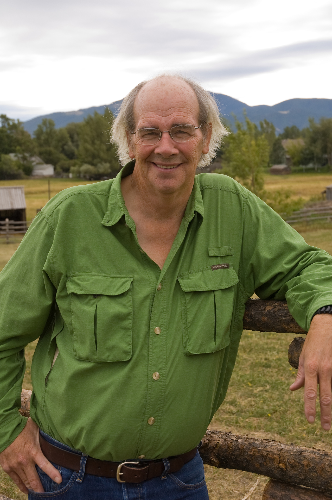John R. Horner

Regents Professor of Paleontology
Curator of Paleontology, Museum of the Rockies
Contact Information
Phone: (406) 994-3170
Email: [email protected]
Education
Geology/Paleontology, University of Montana
Honorary Doctorate, University of Montana
Honorary Doctorate, Pennsylvania State University, 2006
Research Interests
I am presently interested in dinosaur evolution and ecology, with emphases on growth and behavior. Studies are conducted in the field where we host the largest paleontological field program in the country. At the Museum of the Rockies we house one of the largest dinosaur collections in the country, and maintain two laboratories, one for the study of cellular and molecular paleontology, and the other for 3-D imaging utilizing data from CT and 3-D scanners. Students committees chaired by Jack Horner have full access to both laboratories, and are encouraged to spend at least one summer in the field.
Current Graduate Students
Alida Bailluel
Brian Baziak
Denver Fowler
Elizabeth Freedman
John Scannella
Katie Tremaine
Cary Woodruff
Badamkhatan Zorigt
Selected Publications
Horner, J.R., Goodwin, M. 2008. Ontogeny of cranial epi-ossifications in Triceratops.
Journal of Vertebrate Paleontology 28(1):134-144.
Chinnery, B., Horner, J.R. 2007. A new neoceratopsian dinosaur linking North American
and Asian taxa. Jornal of Vertebrate Paleontology 27(3):625-641.
Horner, J.R., Goodwin, M. 2006. Major cranial changes in Triceratops. Proceedings
of the Royal Society (B):273:2757-2761.
Horner, J. R, Padian, K, and Ricqles, A. de. 2005. How dinosaurs grew so large and
so small. Scientific American 293(4):32-39.
Schweitzer, M. H., J. L. Wittmeyer, J. R. Horner, and J. B. Toporski. 2005. Soft-tissue vessels and cellular preservation in Tyrannosaurus rex. Science 307:1952-1955.
Schweitzer, M. H., Wittmeyer, J. L., and Horner, J. R. 2005. Gender-specific reproductive tissue in ratites and Tyrannosaurus rex. Science 308:1456-1460.
Main, R.P., Ricqles, A. de, Horner, J.R., and Padian, K. 2005. The evolution and function of thyreophoran dinosaur scutes: implications for plate function in stegosaurs. Paleobiology 31(2):291-314.
Horner, J.R., Padian, K. 2004. Age and growth dynamics of Tyrannosaurus rex. Proceedings Royal Society (B) 271 (1551):1875-1880.
Goodwin, M. and Horner, J. R. 2004. Cranial histology of pachycephalosaurs (Ornithischia: Marginocephalia) reveals transitory structures inconsistent with head-butting behavior. Paleobiology 30(2):253-276.
Ricqlès, A. de, K. Padian, J. R. Horner. 2003. On the histology of some Triassic pseudosuchian archosaurs and related taxa. Annales de Paléontologie 89:67-101.
Ricqlès, A. de, K. Padian, J. R. Horner, E. Lamm, N. Myhrvold. 2003. Osteohistology of Confuciousornis anctus (Theropoda: Aves). Journal of Vertebrate Paleontology 23(2):373-386.
Horner, J. 2002. Evidence of dinosaur social behavior. Chapter 9, pp 71-78 in Dinosaurs, The Science behind the Stories, American Geological Institute, Alexandria, Virginia.
Padian, K. and Horner, J. R. 2002. Typology versus transformation in the origin of birds. Trends in Ecology and Evolution 17(3):120-124.
Horner, J. R., Padian, K., and Ricqlès, A. de 2001. Comparative osteohistology of some embryonic and perinatal archosaurs: developmental and behavioral implications for dinosaurs. Paleobiology 27(1): 39-58.
Padian, K., A. J. de Ricqlès, and J. R. Horner. 2001. Dinosaurian growth rates and bird origins. Nature 412:405-408.
Horner, J. R. 2001. Dinosaur Ethology, pp. 416-419 in Palaeobiology II, edited by Briggs and Crowther (Blackwell Science, Oxford).
Horner, J. R. 2000. Dinosaur reproduction and parenting. Annual Reviews of Earth and Planetary Sciences 28:19-45.
Horner, J. R., Ricqlès, A. de, and Padian, K. 2000. Long bone histology of the hadrosaurid Maiasaura peeblesorum: growth dynamics and physiology based on an ontogenetic series of skeletal elements. Journal of Vertebrate Paleontology 20(1):109-123.
Horner, J. R., Ricqlès, A. de, and Padian, K. 1999. Variation in dinosaur skeletochronology indicators: implications for age assessment and physiology. Paleobiology 19(4):295-304.
